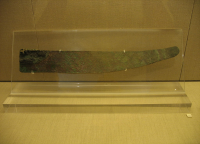








A saw is a tool consisting of a hard blade, wire, or chain with a toothed edge. It is used to cut through relatively hard material, most often wood. The cut is made by placing the toothed edge against the material and moving it forcefully back and forth. This force may be applied by hand, or powered by steam, water, electricity or other power source. An abrasive saw has a powered circular blade designed to cut through metal.
Saws were at first serrated materials such as flint, obsidian, sea shells and sharks teeth.
In ancient Egypt, open (unframed) saws made of copper are documented as early as the Early Dynastic Period, circa 3,100–2,686 BC. Examples of saws used for cutting both wood and stone and as a tool for execution of people and models of saws have been found in many contexts throughout Egyptian history. Particularly useful are tomb wall illustrations of carpenters at work that show sizes and the use of different types. Egyptian saws were at first serrated, hardened, copper which cut on both pull and push strokes. As the saw developed teeth were raked to cut only on the pull stroke and set with the teeth projecting only on one side, rather than in the modern fashion with an alternating set. Saws were also made of bronze and later iron. In the Iron Age frame saws were developed holding the thin blades in tension.The earliest known sawmill is the Roman Hierapolis sawmill from the third century AD and was for sawing stone.
According to Chinese legend, the saw was invented by Lu Ban.In Greek mythology, as recounted by Ovid,Talos, the nephew of Daedalus, invented the saw. In archeological reality, saws date back to prehistory and most probably evolved from Neolithic stone or bone tools. ""The identities of the axe, adz, chisel, and saw were clearly established more than 4,000 years ago.""
Manufacture of saws by hand:
Until at least the mid-19th century, saws were made laboriously by hand. The teeth were filed out individually, then ""set"" by striking alternate teeth with a hammer against a ""stake"" or small anvil. Due to risk of breaking teeth, beginners were given saw set pliers which set even more slowly.
Pit saws:
A pit saw was a two-man rip saw. In parts of early colonial North America, it was one of the principal tools used in shipyards and other industries where water-powered sawmills were not available. It was so-named because it was typically operated over a saw pit, either at ground level or on trestles across which logs that were to be cut into boards by the pit-saw were mounted. The pit saw was ""a strong steel cutting-plate, of great breadth, with large teeth, highly polished and thoroughly wrought, some eight or ten feet in length""with either a handle on either end or a frame saw. A pit-saw was also sometimes known as a whipsaw.It took 2-4 people to operate. A ""pit-man"" stood in the pit, a ""top-man"" stood outside the pit, and they worked together to make cuts, guide the saw, and raise it.Pit-saw workers were among the most highly paid laborers in early colonial North America.